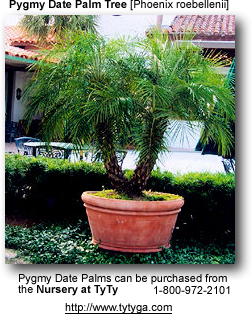Date Palm Trees

Dwarf / Pygmy Palm Trees are slow-growing trees that make decorative indoor or outdoor plants.
🌱 Air Purification: It is one of the best palms for removing indoor air pollutants and is especially effective for the removal of xylene.
About the Phoenix Palm
The Phoenix Palm is amongst the most durable of all palms. This palm is very hardy, drought tolerant, and very long-lived if planted in the correct environment. It requires little care other than lots of water and fertilizer during the hot months, and giving palms a little extra nitrogen during the growing season keeps them looking their best.
The dates grown on the pygmy date palm tree are about one-half the size of commercial dates, and the same brown-black color. Pygmy date palm trees, Phoenix roebellenii, trunks can grow 10 feet tall and taper smaller at the bottom, making very decorative specimens in garden landscapes and as office plants.
Placement
🏠 Indoor Placement
Most palms need bright natural light year-round. Filtered light near a south-east or west-facing window (within 3 to 5 feet) is suitable. The Pygmy date palm will grow well in low to medium light environments, but will not generally succeed in dark indoor corners.
🌳 Outdoor Placement
If planting outdoors, choose a well-protected site, either next to a wall, building, or house (south side preferred) or under a large tree. The palm will grow well in medium light or even full sun if watered regularly on hot, dry summer days.
Care Instructions
💧 Watering
Palms prefer to stay moist. Water thoroughly once a week when soil is dry 2 inches deep. Mist a couple times weekly. Never let dry out or stand in water.
🌡️ Temperature
Prefer 60°F at night, 70-80°F during day. Protect from drafts. Cool temperatures (55-60°F) during winter benefit growth.
🌱 Soil & Potting
Use porous soil with organic matter for moisture and drainage. Repot every 2-3 years in spring/early summer when roots fill pot.
🧪 Fertilizer
Use dilute liquid or slow-release fertilizer only during active growth. Excess fertilizer can harm palms. Extra nitrogen during growing season helps.
🧼 Cleaning
Regularly rinse foliage with lukewarm water spray to clean leaves and control insects like scale, thrips, and mites.
✂️ Pruning
Cut off lower leaves as frond tips become discolored to highlight the trunk. Most palms propagate from seed; some can be divided.
Potential Problems & Solutions
💧 Watering Issues
Under-watering
Plant begins to droop and may never return to normal shape.
Over-watering
Foliage tips turn black or yellow. Can lead to root rot.
🌡️ Environmental Issues
Cold Injury
Causes reddish-brown dead areas on leaves after a few days.
Too Much Sun
Yellow or black spots on foliage. Move away from direct sunlight.
🌿 Care Issues
Excessive Fertilization
Tips of lower leaves turn brown and die.
Dry Air/Lack of Water
Browning of leaves. Increase humidity and check watering schedule.
Spider Mites
Watch for in hot, drafty areas as they spread rapidly.
⚠️ Important Notes
- • Do not use leaf-shining products on palms as they can severely injure the foliage
- • If new growth is damaged, it can be difficult to restore the palm's original appearance
- • You may prune yellowed or blackened tips to improve plant appearance